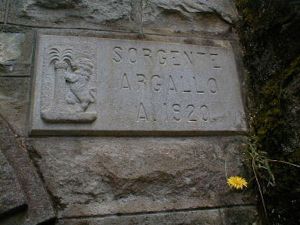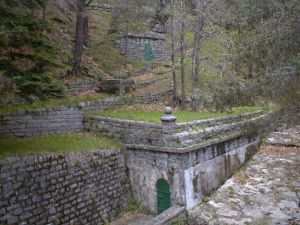It was only thanks to Siro Andrea Carli, who was elected mayor on 24 February 1827, that his first initiative was to tackle the problem of the city's water supply, which urgently needed new sources in addition to those mentioned above, as the people of San Remo had been suffering from drought for some time and were forced to draw water from a number of wells.
With the support of the Intendant Alberto Nota, he made his project known to the population. The inhabitants of Sanremo enthusiastically accepted the proposal and both rich and poor competed to help with the work by lending themselves to all the heavy transport services for the building materials. However, there was fierce opposition to the implementation of the aqueduct project and an appeal was lodged with the Intendancy against the Council Resolution (24 April 1828) on the grounds of « the damage to the waters used to water the lemon gardens and to run the oil and grain mills" and because it was feared "that it would be very difficult to bring water to the town with the success desired and believed ».
The town council then commissioned the senior aide of the Royal Corps of Civil Engineers, Gio Batta Luigi Clerico, to find a spring in the Sanremo area capable of supplying water to the town, which was eventually identified as the one situated on the slopes of the Pian di Castagna mountain, in the locality of Lago Nero.
It was therefore thanks to the magnanimity of the Ammirati family, with a regular deed of the Notary Francesco Donetti dated 21 October 1828, that « they were pleased to grant this Magnificent Community a free concession of a spring of water rising in their woodland and chestnut woods in this territory called Breschi, near the so-called Lago Negro ». On 2 August of the same year, they made only one petition, in which, although they knew that the water channel would benefit all the inhabitants of the town, they asked that « the water conducted in the channel be used for the profit and advantage of the same, i.e. of their land situated in the place called Cardellina, or Gogna, which is lower down and adjacent to the canal, a trickle of water of the volume of half an ounce of Genoa, so that they could use it to irrigate their land under cultivation, after the same water had been used by the public, in a fountain to be erected in another of the upper parts of the land ».
Naturally this request was approved by the Municipality, which wrote: « We approve and give due praise to the zeal of Mr and Mrs Ammirati for the voluntary and free concession of a water belonging to them. Sanremo 25 September 1828, the Intendant notes ».
Some technical data: According to the existing data in the Municipality the length of the canal, from the spring to the Porta di San Nicola (Porte di Santa Maria), was 4,136 metres, with a difference in level of 317.71 metres. The canal was made of masonry, 0.20 metres wide, 0.16 metres high, with a curved bottom and covered with slabs. In addition, there were 757 metres of well-painted terracotta pipes, 0.50 metres long, 0.12 metres in diameter, set 0.08 metres apart to carry water from 399 metres before the Porta di San Nicola (St Nicholas Gate) to the various fountains in the town, a total distance of 4,971.20 metres.
The tanks were and are made of Balzi Rossi limestone and their construction was contracted and approved on 17 June 1828 to Francesco Serra di Vincenzo.
After the construction of the aqueduct and the overcoming of a number of disputes concerning the state, on 15 August 1829 the water was finally able to flow for the first time and reach the various districts of the city through special branches of the pipes, making it possible to build four fountains: in Piazza dei Dolori, Piazza Santo Stefano, Piazza del Mercato, and later the fountain in Piazza dei Missionari.
Of the fountains built, those in Piazza dei Dolori, Piazza Santo Stefano (or Piazza Nota) and Piazza dei Missionari (today Piazza Bresca) still retain their original design.
To celebrate the happy event, the Piacenza man of letters Pietro Giordani wrote an epigraph that was walled on an aqueduct pipe along the road that leads from the sanctuary of the Madonna della Costa to the village of San Giacomo. The text of the epigraph, which was allegedly destroyed by a vandal in 1885, read as follows: « MDCCCXXVI / The Council of the Municipality / at the request of Alberto Nota R.° Intendente / by A. Carli Sindaco / in the city that drank scarce and guilty / led for more than VM metres / excellent water / overcame the difficulties of the work / greatly shortened the time and expenses / by universal and general concurrence / of every order of citizens ».
The importance of having access to clear, fresh water was very much felt by the citizens, since, as Francesco Onetti would point out: « Drinking water is healthy when it is clear, odourless, with a pleasant taste..., when it cooks dry vegetables and meat with alacrity, and dissolves soap well without becoming cloudy or producing any pollution ».
Until the 1860s, the town's overall water supply was adequate for its needs. The two hundred cubic metres of water from the Lagonero spring were almost exclusively used as drinking water, while water from wells was preferred for domestic and irrigation purposes.
It was in the 1970s that the problem of an increased and improved water supply became apparent. In the course of that decade, in fact, the resident population grew considerably and the number of tourists increased, as did municipal needs and individual consumption due to changes in hygiene habits.
Thus, in 1876, the municipal council resolved to set up a commission to study a water diversion from the Roja river, which would have allowed a large supply, able to meet the needs of agriculture as well. Towards the end of the decade, a call for tenders was issued and several companies were asked to submit suitable projects to the council.
In the meantime a government concession for the exploitation of the river had been obtained, but no entrepreneur came forward with projects to submit to the municipal councillors, probably because of the great distance of the Roja river from Sanremo and the impervious nature of the territories to be crossed, factors that imposed costly studies and the resolution of difficult hydraulic engineering problems.
It was on the initiative of the liberal-catholic administration of Bartolomeo Asquasciati (1878-1891) that the programme for an Aqueduct adapted to the new needs of the city was developed.
In spite of the short-sightedness of many of his fellow countrymen, who out of misery, or out of modest and unhygienic conceptions of life, or out of sterile private interests (such as defending against the uprooting of some lemon or even olive trees along the route of the work, or because of a wild and antisocial concept of property rights with regard to the workers assigned to temporary public works on their land) did not see the civil necessity of building an aqueduct to provide the city and its agriculture with abundant water, Asquasciati, overcoming all this resistance, sponsored and carried out (he did not propose programmes except to implement them) the grandiose work of a Municipal Aqueduct.
Before then, in the city, water was fetched from the fountain by bucket, and these fountains by the well-deserving Siro Andrea Carli were in any case insufficient for the growing population. In the countryside, if there was a well on any land, the owner's garden or field was envied and longed for by the neighbours as if it were a Promised Land.

 This brought us to 1882, the year in which an agreement was finally reached, and then finalised in a contract, with the Société Lyonnaise del Eaux et Eclairage, which undertook to bring to Sanremo not the waters of the Roja, but those of the Argallo springs, already purchased to supply Ospedaletti. The Société Lyonnaise undertook to build a pipeline capable of supplying 4,000 cubic metres per day to Sanremo and 200 to Ospedaletti, which would be reached by a branch line. Furthermore, as soon as the town had obtained the government concession, the transalpine company undertook to increase the cubic metres for Sanremo to 7,500, by diverting water from the Oxentina river.
This brought us to 1882, the year in which an agreement was finally reached, and then finalised in a contract, with the Société Lyonnaise del Eaux et Eclairage, which undertook to bring to Sanremo not the waters of the Roja, but those of the Argallo springs, already purchased to supply Ospedaletti. The Société Lyonnaise undertook to build a pipeline capable of supplying 4,000 cubic metres per day to Sanremo and 200 to Ospedaletti, which would be reached by a branch line. Furthermore, as soon as the town had obtained the government concession, the transalpine company undertook to increase the cubic metres for Sanremo to 7,500, by diverting water from the Oxentina river.
The studies for the canalization had already begun when serious problems arose between the French engineers and the populations of Badalucco, Vignai and Zerbi, who valued centuries-old usufruct rights over the springs that were about to be introduced into the conduits. The Société Lyonnaise thus cancelled the contract and was replaced by the engineer Giovanni Marsaglia, who took over the task of supplying the town on the same terms as the transalpine company.
AQUEDUCTS - Aqueduct Siro Andrea Carli
Article Index
Page 2 of 5




